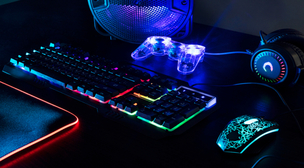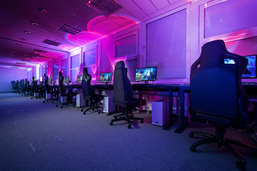Updated January 25, 2022
The Best 4K Gaming Monitors
The best 4K gaming monitor is the perfect way of justifying spending a huge pile of cash on a high-end graphics card. Especially today, when the few GPUs that are available are all priced like high-end graphics cards, no matter what silicon they have inside them.
But, it must be said, that even the Nvidia GeForce RTX 3060 Ti and AMD Radeon RX 6700 XT can be surprisingly capable when it comes to 4K. This means that when GPU supply returns to something like normality, back in, say, late 2022, we might actually have some next-gen cards on the way. And those should pretty much all be 4K-capable.
In most cases, you're going to want a VA or IPS panel, with a refresh rate above 60Hz, and some form of frame-syncing capability—either G-Sync or FreeSync. You also need to decide whether to up-size with one of the best gaming TVs instead, for deeper immersion. If you have space, that is.
Spending that little more on one of the best 4K gaming monitors is certainly worth it, especially when you consider it should see you through a decade of action-packed, next-gen gaming. It'll be able to produce breathtaking visuals for all those years, spanning many iterations of your Theseus’ ship of a PC. Think of it as a long-term investment, basically, but one that you also get to enjoy today.
Best 4K monitors for gaming
Image 1 of 4
1. LG 27GN950-B
The fastest, most responsive 4K gaming monitor
SPECIFICATIONS
Screen size: 27-inch
Panel type: Nano IPS
Aspect ratio: 16:9
Resolution: 3840x2160
Response time: 1 ms
Refresh rate: 144 Hz
Weight: 16.9 lbs
TODAY'S BEST DEALS
REASONS TO BUY
+Bright vivid colors+G-Sync/FreeSync compatible+Excellent Response time for a 4K monitor
REASONS TO AVOID
-Colors tend to be oversaturated
4K gaming is a premium endeavor. You need a colossal amount of rendering power to hit decent frame rates at such a high resolution. But if you're rocking a top-shelf graphics card, like the GeForce RTX 3080, then this dream can finally be a reality.
The LG UltraGear is the first 4K Nano IPS 1ms gaming monitor capable of properly showing off your next-gen GPU. This 4K 27-inch HDR monitor has a 144Hz refresh rate and 1ms response time—wild for a 4K monitor. What is most impressive about this LG is the Nano IPS tech that offers a wider color gamut and stellar viewing angles.
The LG UltraGear 27GN950-B bags you a terrific panel with exquisite IPS image quality and, despite the lesser HDR capabilities, beautiful colors and contrast in your games too. G-Sync offers stable pictures and smoothness in games, and the speedy refresh rate and response times back this up too.
Image 1 of 4




2. Acer Predator XB273K
The best 4K monitor for gaming, offering quality and value
SPECIFICATIONS
Screen size: 27-inch
Panel type: IPS
Aspect ratio: 16:9
Response time: 4 ms
Refresh rate: 144 Hz
Weight: 15.9 lbs
TODAY'S BEST DEALS
Prime
Prime
444 Amazon customer reviews☆☆☆☆☆
REASONS TO BUY
+Brilliantly detailed pictures+Offers fast refresh and response times+Excellent value for a high spec monitor
REASONS TO AVOID
-Contrast could be better
Advertisement
A close cousin of the Acer Predator X27, itself once the top of this pile, the XB273K is a seriously excellent 4K monitor. It harnesses everything the X27 does, trading off very little to rehouse it in a far cheaper model.
Now often found sitting way below the $1,000 mark, it is immediately more tempting than the Acer X27, and the only real change is in the HDR; the XB273K has a slightly lower quality of HDR. But that's about it. And considering the still nightmarish state of HDR gaming on PC, that's not a huge miss.
You'll still get a truly excellent picture quality, with terrific color vibrancy, contrast, and depth; the 144Hz refresh rate means it's excellent for competitive shooters. G-Sync offers the best adaptive sync technology, an impressive array of ports covers you, and overall it offers such a well-rounded overall experience you'll have zero regrets.
Read the full Acer Predator XB273K review.
Image 1 of 4




3. LG 27UL650
A great budget 4K Monitor
SPECIFICATIONS
Screen size: 27-inch
Panel type: IPS
Aspect ratio: 16:9
Response time: 5 ms
Refresh rate: 60 Hz
Weight: 13.9 lbs
TODAY'S BEST DEALS
REASONS TO BUY
+Great color accuracy+FreeSync compatibility +Awesome Design
REASONS TO AVOID
-No HDR-No local dimming
Advertisement
The LG 27UL650 is a killer 4K gaming monitor you can find for under $500. This IPS panel display has improved color and contrast over its predecessor and offers lower input lag for gaming.
Suppose you do more than gaming; this LG displays sports deliciously precise color accuracy and HDR10, making watching movies and editing a worthwhile endeavor. The only real downside is the standard 60Hz refresh rate and the fact the monitor has no built-in speakers, so you'll have to invest in a good pair of headphones and/or desktop speakers, as well. But generally, we'd recommend that over pretty much any tinny display speaker anyway.
Image 1 of 4




4. Eve Spectrum ES07D03
A stunning panel, with HDMI 2.1 support for the console crowd.
SPECIFICATIONS
Screen size: 27-inch
Panel type: Nano IPS
Aspect ratio: 16:9
Response time: 5 ms GtG
Refresh rate: 144 Hz
Weight: 14.8 lbs
TODAY'S BEST DEALS
REASONS TO BUY
+Excellent design+Fantastic LG IPS panel+Broad connectivity options
REASONS TO AVOID
-Poor HDR and local dimming-High sticker price
Advertisement
After a rocky start with its ill-fated foray into the world of tablets, Eve has smashed it out of the park with the Spectrum ES07D03. It's a beautifully designed gaming monitor, with a stunning LG panel, and all the features you could possibly want from a modern screen. That's the result of a crowd-designed creation process for the Spectrum, and it certainly looks like it's paid off.
Except for those wanting decent HDR. With a peak luminance of 750cd/m2, and a little local dimming in its backlighting array, I was hoping for a little more pizazz in my HDR scenes. Sadly, that's still a struggle for PC gaming and its monitors. But everything else the Eve Spectrum does has blown me away. The LG Nano IPS panel is superb, with vibrant colours, and great motion, and I'm a little bit in love.
The Spectrum also rocks HDMI 2.1 support so it can deliver its full 144Hz promise across PC and next-gen console at 4K, something you previously needed a DisplayPort connection to do.
Like any 4K/144Hz screen you could mention, the price tag is potentially prohibitive. But gaming monitors are investments, and this is a screen that will outlast your current PC, and potentially your next one too. So it's always worth spending what you can possibly afford on a new screen.
Read our full Eve Spectrum review.
Image 1 of 3



4. Asus ROG Swift PG27UQ
The best premium-price 4K monitor
SPECIFICATIONS
Screen size: 27-inch
Panel type: IPS
Aspect ratio: 16:9
Response time: 4 ms
Refresh rate: 144 Hz
Weight: 28 lbs
TODAY'S BEST DEALS
489 Amazon customer reviews☆☆☆☆☆
REASONS TO BUY
+Cool design+Great image quality and includes Nvidia G-Sync technology+144Hz refresh rate
REASONS TO AVOID
-Not great contrast-Thick Bezels
Advertisement
Perhaps a little obvious, but packing lots of top-end features into a display means it’ll come with a high price tag. The Asus ROG Swift PG27UQ is an incredible display but it doesn't come cheap. That money does net you more features than any other display here and perhaps that's enough to set it apart. As well as the ridiculously clear, bright and detailed images that the PG27UQ’s 4K and HDR-enabled 27-inch display shows off, this monitor also incorporates Nvidia G-Sync tech, making this an absolute behemoth of a screen. Though we do wish the contrast was slightly better on this nearly perfect screen.
On the back, it’s a bit lean on the connections, but you should have everything you need: present are an HDMI 2.0 input, DisplayPort 1.4, 3.5mm audio, and two USB 3.0 ports. It’s also an incredibly well-designed bit of kit with the stand effectively funneling cables, as well as looking cool. I especially like the ROG eye that shines on the surface wherever you put the monitor.
The list price is very high, so it might well put people off, but it will not disappoint those who take the plunge.
Read the full Asus ROG Swift PG27UQ review.
Best graphics cards | Best gaming motherboards | Best CPU for gaming
Best DDR4 RAM | Best Gaming PC build | Best gaming monitor
Image 1 of 3



5. Philips Momentum 558M1RY
The best MASSIVE 4K gaming monitor
SPECIFICATIONS
Screen size: 55-inch
Panel type: VA
Aspect ratio: 16:9
Response time: 4 ms
Refresh rate: 120 Hz
Weight: 58.4 lbs
TODAY'S BEST DEALS
REASONS TO BUY
+TV scale but with DisplayPort+Bright and colourful+Built-in B&W soundbar+MASSIVE
REASONS TO AVOID
-Some inverse ghosting
Advertisement
YOUR NEXT UPGRADE

Best CPU for gaming: The top chips from Intel and AMD
Best graphics card: your perfect pixel-pusher awaits
Best SSD for gaming: Get into the game ahead of the rest
I am utterly entranced by the sheer scale and majesty of Philips' 55-inch monitor behemoth. Outside of Nvidia's abortive BFGDs, there is no other PC monitor that can match this monster. But despite its impressive size and speed, there are still shortcomings which, while they're not deal-breakers, do need to be considered.
But first the good. This 4K VA panel rocks up with a DisplayHDR 1000 certificate, and the ability to render its 3840x2160 native resolution at speeds of up to 120Hz. Sadly, for console gamers, its HDMI version is only 2.0 and so your next-gen game boxes will be restricted to 4K/60. The Series X will hit 120Hz at 1440p, however, although the PS5 still neglects that option.
For us PC folk, that's no issue, as the Philips display supports DisplayPort 1.4 so we can get the full 4K res at a zippy 120Hz. Coupled with its bright, vibrant panel, that makes the screen great for smooth 4K gaming. And I'm still smitten by Philips' Ambilight technology, which rings the back of the display with RGB LEDs that can alter hues individually to match their corresponding color on the panel itself.
My only real reservations surround some of the response settings. To make the large panel responsive Philips offers different levels of SmartResponse, but the more aggressive you get on those settings the more inverse ghosting you tend to get on high contrast moving images. Playing FIFA at 4K and I could notice issues around the edges of players. But if you're smashing through Doom Eternal, however, it's just going to be the smooth motion and vibrant colors that stand out. That and the gibs, obvs.
Best 4K gaming monitors FAQ
Is a 4K gaming monitor worth it for PC gaming?
The biggest thing to consider is whether you have a PC capable of making a 4K gaming monitor worth it. Upgrading to one of the best graphics cards will ensure your machine will not just be rendering a gaming slideshow with the step-up to 4K. It would help if you also aimed for a larger screen size too.
The first 4K monitor we ever tested was glorious but was only a 24-inch panel, so we couldn’t quite appreciate the 8.3 million pixels we were generating. Step that up to the 55-inch Philips Momentum monitor and your high resolution world is writ large.
How do we test 4K gaming monitors?
There are two main ways to test a screen to determine whether it's the best gaming monitor material. The first is by playing games on it. Subjectively testing the gaming performance of each panel isn’t necessarily going to give you the lowdown on the specifics of a particular screen. Still, it will let you test the functioning aspect ratio, native resolution, and any specific gamer-centric technologies they’re sporting.
Side-by-side comparative testing in this manner is also precious for keying into the sometimes subtle differences between each panel. When you use a screen in isolation, it’s easy to become blind to its comparative faults as you get used to them. Testing screens back-to-back allows us to discover and highlight specific issues between them.
We also use a heap of standardized tests produced by Lagom to ensure levels and saturation are visually up to our standards.
To read the latest guides, news, and features you can visit our Other Game Page.







